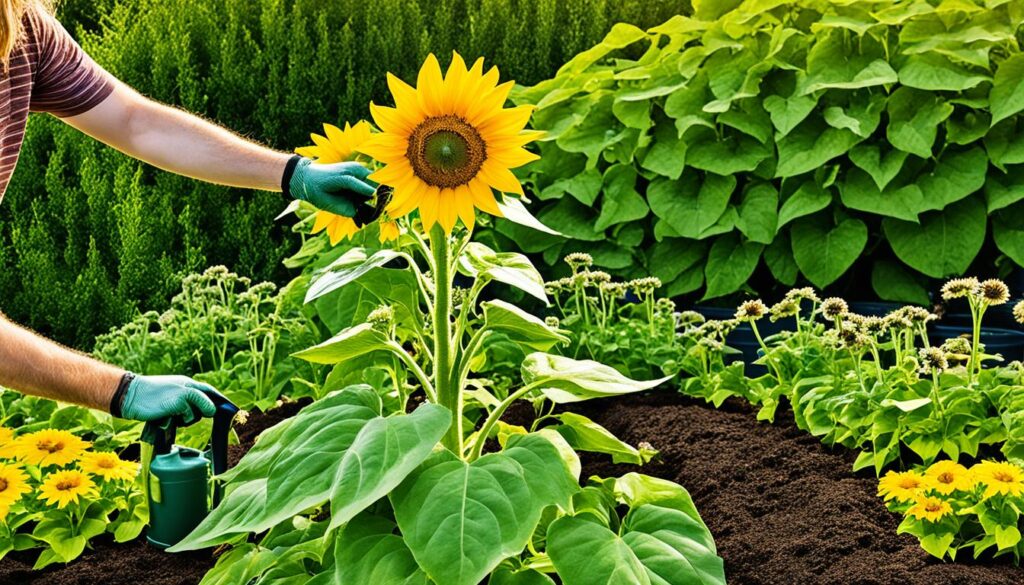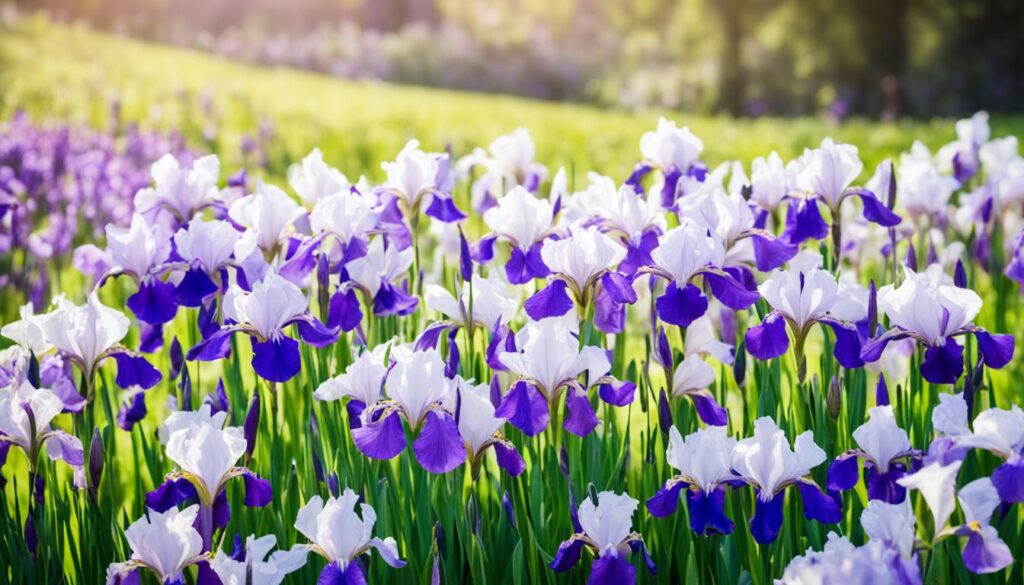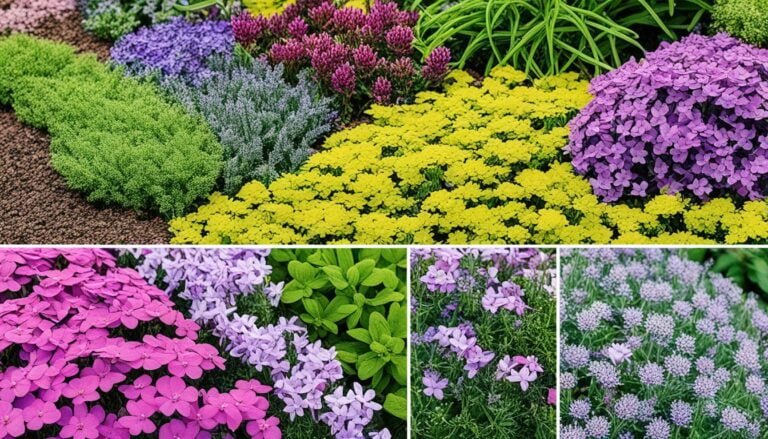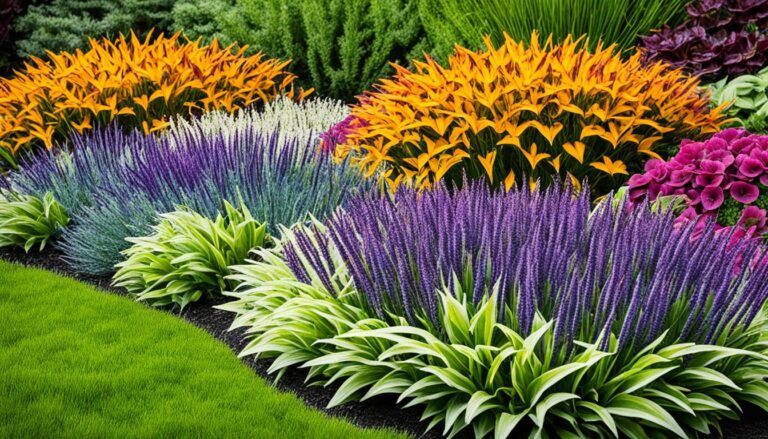Big Beautiful Flowers For centuries, flowers have symbolized love, beauty, and peace. They are not just pretty; they make us happy and can even speak our feelings. The big beautiful flowers we see today each have their special qualities and needs. Whether it’s the classic rose or the full-bloom peony, every flower brings its unique beauty to the world.
Roses are known worldwide for their beauty, colors, and scents. They represent love and romance like no other flower. Peonies, with their lush petals, are symbols of prosperity and bring happiness. When we look at flowers, we see nature’s poetry. It’s a way for us to feel closer to the natural world and appreciate its wonders.
Key Takeaways
- Flowers symbolize love, beauty, and tranquility.
- The guide features 301 different types of beautiful botanical specimens.
- Roses and peonies are popular choices for their elegance and prosperity symbolism.
- Big beautiful flowers enhance both aesthetics and aromatic experiences.
- Understanding each flower’s growing conditions is key to vibrant flower varieties.
Stunning Roses: Symbols of Love and Elegance
Roses are known for their velvet petals and sweet smells. They symbolize love and beauty around the world. With so many types, they fit perfectly in gardens or bouquets.
Varieties of Roses
Roses come in many forms, meeting everyone’s preferences. For instance, the Victor Hugo Rose flowers from spring to fall and has 25 petals. On the other hand, the Winchester Cathedral Rose boasts over 80 petals. There’s also the Michelangelo Rose, which offers 40 creamy yellow petals. For a unique touch, the Gold Medal Rose has dark gold petals with about 30 petals per bloom. The Black Baccara Rose, known for its romance, has 45 petals in a 4-inch wide bloom. Additionally, the Rose By Sara Verdier is a special real rose that lasts forever, adding a stylish touch.
Best Growing Conditions for Roses
Roses need plenty of sun, well-drained soil, and regular care. Following these steps keeps them looking healthy and beautiful. This is important to keep them as the elegant symbols of love they are.
Uses of Roses in Arrangements
Roses are versatile and perfect for many kinds of arrangements. They add beauty to bouquets, gardens, and special events. Not only are they pleasing to the eye, but they also fill the air with a sweet scent.
- Variety
- Victor Hugo Rose: Over 25 petals per bloom, Spring through Fall
- Winchester Cathedral Rose: Over 80 petals, blooms 2″ across
- Michelangelo Rose: 40+ creamy butter yellow petals
- Gold Medal Rose: Approximately 30 dark gold petals
- Black Baccara Rose: 45 petals, blooms 4″ across
- Rose By Sara Verdier: Preserved real rose, lasting forever
| Rose Variety | Petal Count | Bloom Size | Season | Unique Trait |
|---|---|---|---|---|
| Victor Hugo Rose | 25+ | Large | Spring-Fall | – |
| Winchester Cathedral Rose | 80+ | 3″ | – | – |
| Michelangelo Rose | 40+ | Creamy Yellow | – | – |
| Gold Medal Rose | 30+ | Dark Gold | – | – |
| Black Baccara Rose | 45 | 4″ | Spring-Fall | – |
| Rose By Sara Verdier | – | Preserved | Lasting Forever | Jewelry Aesthetic |
Peonies: Lush Blooms for a Prosperous Garden
Peonies are ancient flowers, known since 1,000 B.C. Some can live up to 100 years. They are loved by gardeners and fans for their big flowers and sweet smell. These flowers come from Asia, Europe, and North America. They are very popular in Asian art and mean prosperity and beauty in China. In the West, they stand for the 12th wedding anniversary.
Color Varieties in Peonies
Peonies bloom in many colors. You’ll find them in white, cream, pink, and even rare yellow. The Paeonia lactiflora is well-known for its big, double blooms. Varieties like ‘Coral Sunset’, ‘Etched Salmon’, ‘White Cap’, and ‘Avalanche’ bring stunning colors to gardens.
Cultivating Peonies Successfully
To grow peonies well, put them in sunny, well-drained spots with good soil. Plant their roots about 2 inches deep. They need support for their blooms.
Water them correctly to avoid root rot. Trim them in the fall to keep them healthy. Use a balanced fertilizer in spring and space them well to avoid pests.
When peonies are set, they can last for a long time. They bring life and color to gardens each year. Many enjoy their flowers in decorations like wreaths.
Big Beautiful Flowers Enchanting Hydrangeas A Three-Season Spectacle
Hydrangeas bring beauty from spring to fall. They fill your garden with colors for most of the year. Their look and growing variety make them perfect for any garden.
Varieties of Hydrangeas
Hydrangeas have many types, each unique. Bigleaf hydrangeas stand out with large blooms. They grow well in zones 5 to 9. In North America, they can grow 5-6 feet tall, making beautiful displays.
Ideal Growing Conditions for Hydrangeas
Bigleaf hydrangeas need sun or light, based on your zone. In zones 4-6, full sun works if you mulch and water. In 7-9 zones, they like the sun or light in mornings. Keep soil moist but not too wet, and feed them monthly from spring to July for more flowers.
- Cold Tolerance: USDA zones 5-9
- Sun Exposure: Full sun to filtered light
- Soil: Moist, well-drained
- Fertilization: Monthly, from early spring through late July
Soil affects how hydrangeas’ flowers look. Rich aluminum soil makes blue flowers; without it, they’re pink. Often, bigleaf hydrangeas don’t have pests, but watch for mildew, spots, and slugs.
| Feature | Details |
|---|---|
| Height | 5-6 feet |
| Sun Tolerance | Zones 4-6: Full Sun Zones 7-9: Filtered Light |
| Soil Type | Moist, well-drained |
| Fertilization | Monthly from early spring to late July |
| Color Variability | Blue (with aluminum), Pink (without aluminum) |
Don’t prune bigleaf hydrangeas much for more flowers. They need little care to show their beauty. Plus, a 60-day guarantee means worry-free gardening.
Magnificent Dahlias: A Burst of Color
Dahlias are known for turning gardens into stunning floral paradises. They come in many colors and shapes, from simple petals to showy dinnerplate flowers. This makes them a top pick for both garden lovers and experts in the field.
Popular Dahlia Types
There are thousands of dahlia varieties to choose from. You might see the giant ‘Mango Madness’ or the more compact ‘Maya’. For height and size, the ‘Penhill Watermelon’ is hard to miss, reaching 5 to 6 feet with massive 10-inch blooms.
Marque dahlia types, such as the classic ‘Thomas Edison’ and the uniquely colored ‘Sincerity’, provide plenty of choices for the discerning gardener.
Planting Dahlias for Maximum Impact
Getting the best out of dahlias means planting them right. They love sandy, well-drained soil and lots of sunlight. It’s also key to consider the hardiness zone when planting, which can be anywhere from 3 to 10.
Here’s a guide for the best times to buy and ship dahlia tubers:
| Zone | Shipping Dates | Last Order Date |
|---|---|---|
| 3A-5A | 4/29/24 – 6/7/24 | 6/3/24 |
| 5B | 4/8/24 – 6/7/24 | 6/3/24 |
| 6A | 3/25/24 – 6/7/24 | 6/3/24 |
| 7A | 2/26/24 – 6/7/24 | 6/3/24 |
| 7B-8A | 2/19/24 – 5/10/24 | 5/6/24 |
| 9B-10B | 2/5/24 – 5/10/24 | 5/6/24 |
Good soil and proper timing are crucial for dahlia growth. When in the right conditions, they can indeed shine, making any garden look amazing.
Buying in bulk can make filling your garden with dahlias more affordable. Whether it’s the big ‘Kelvin Floodlight’ or the detailed ‘Jowey Frambo’, getting more for less improves the beauty of your garden without breaking the bank.
Big Beautiful Flowers How to Grow and Care
Growing and caring for big, beautiful flowers isn’t just about looks. It involves proper watering, fertilizing, and keeping pests away. By knowing what each flower needs, you can grow stunning blooms in your garden.
Hydrangea arborescens ‘Annabelle’ bursts with 12-inch wide flowers. ‘Incrediball’ hydrangeas stand out with strong stems. Delphinium elatum ‘Pacific Giant’ has 3-inch double flowers. It reaches an impressive 7 feet in height. Clematis ‘Fireworks’ boasts flowers as large as 8 inches, showcasing the variety available.
Choosing the right soil is key when planting. These flowers prefer well-drained, fertile soil. The climate is also crucial, with planting zones from 3 to 11. Some, like the ‘Mammoth’ sunflower, grow heads as big as 12 inches on 16-foot stalks.
Watering well is a must for these plants. Many need deep, regular watering to stay healthy. For instance, the hardy hibiscus requires plenty of moisture. Yet, some lilies do well with less water.
Choosing a good spot in your garden matters too. Different flowers need different light, from full sun to partial shade. For example, tree peonies do best in bright spots, while some clematis like a bit of shade.
It’s also important to know when these flowers bloom. Some, like delphiniums and clematis, need support as they grow. With the right care, your garden will be filled with vibrant flowers that everyone admires.
Big Beautiful Flowers Gorgeous Garden Blossoms Irises
Irises bring beauty and flair to any garden. They come in many shapes and colors. Each type can make your garden shine in its own way.
Different Types of Irises
Each type of iris is special. The Tall Bearded Iris is loved for its design and height. It does well in Santa Cruz, California. The Siberian Iris ‘Caesar’s Brother’ thrives in hot Southern California. Then there are the Pacific Coast Irises that prefer cooler areas like Santa Cruz.
Some irises are even more unique. The ‘Edith Wolford’ iris from Boise, Idaho, is known for its beauty and scent. The ‘County Cork’ is an unusual green type. It adds a rare color to gardens.
Growing Conditions and Care for Irises
Irises need specific care to grow well. They like soil that drains well and lots of sun. In places like Santa Cruz, they benefit from regular rain. This helps them bloom beautifully.
Proper care is important for irises. This means spacing them out and dividing them regularly. It stops them from overcrowding. Sherry Austin’s garden shows the result of such care, with large, healthy iris clumps.
People who love irises, like Joel Schaber, pay a lot of attention to detail. They choose irises not just for their beauty but also for how they smell and the type of leaves they have. In Minnesota, Marte Hult’s garden is a great example of thoughtful planning. It shows off the irises’ colors and contrasts well.
Keeping irises healthy is about more than just planting them right. Regular feeding and dividing every few years is key. With this regular care, your irises can keep blooming and delighting you year after year.
| Gardener | Location | Preferred Iris Variety | Remarkable Traits |
|---|---|---|---|
| Sherry Austin | Santa Cruz, CA | Tall Bearded & Pacific Coast | Sprawling garden with historic varieties |
| Joel Schaber | Boise, ID | ‘Edith Wolford’ | Meticulous planning and maintenance |
| Pauline Lavigne | Canada | Variety of Irises | Grows alongside peonies, daylilies, hostas |
| Marte Hult | Minnesota | Various Irises | Skill in color coordination and contrast |
| — | Southern CA | ‘Caesar’s Brother’ | Excellent growth in hot inland areas |
Vibrant Sunflowers: Nature’s Smiling Faces
Sunflowers are known for their big, bright blooms and tall stalks. They bring joy and a sense of wonder. Some grow as tall as 10 feet. They started in the Americas and made their way to Europe in the 16th century. People found uses for them beyond their beauty, like in cooking and farming.
A sunflower’s head is made of tiny flowers. These flowers turn into seeds, which birds and animals love to eat. Sunflowers need good care to reach their full height. They start blooming for just a short time before making seeds. When they fully bloom, they turn any place into a spot of summer beauty.
Did you know, 98% of pictures of sunflowers online show them in full bloom? They are often called nature’s “smiling faces”. Sunflowers show us a natural cycle of life. It includes blooming, seed making, and then starting all over again.
But sunflowers aren’t just pretty; they’re useful too. After the Fukushima disaster, they were used to clean the soil from radiation. This shows their amazing power to help the environment, not just look good.
| Aspect | Details |
|---|---|
| Height | Up to 10 feet |
| Origin | Americas, introduced to Europe in the 16th century |
| Bloom Period | Few days before seeds ripen |
| Ecological Role | Food for birds and animals, seed production |
| Environmental Use | Radiation absorption in Fukushima |
In conclusion, sunflowers add more than just beauty. They provide food, help clean up, and show nature’s strength. Their blooms reflect the true beauty and power of our natural world.
Luxurious Lilies: Majesty in Every Petal
Lilies are among the most elegant and grand flowers. They come in over 2,000 varieties. Each type is special, like the Asiatic lilies with bright colors or the large Oriental lilies. Gardeners and flower lovers cherish their beauty.
Varieties of Lilies
Petals & Stems, a top florist in Dallas, offers gorgeous flowers. They have Asiatic lilies for those who love color but not scent. They also provide Oriental lilies, known for their purity and beauty. With lilies like the Acapulco and Altaria, they have flowers for every taste.
Planting and Care Tips for Lilies
To grow lilies well, start with good, draining soil and sun. Some types may need support as they grow tall. Keeping the soil healthy and moist is important. Lilies such as the African Queen and Anastasia can make your garden vibrant. They also attract beneficial insects.
Uses of Lilies in Floral Arrangements
Lilies are perfect for making events elegant. Their large, beautiful petals add sophistication to bouquets. Petals & Stems excels in creating stunning arrangements for weddings or memorial services. They aim to make every bouquet stylish and special. Lilies are a timeless choice for celebrations and quieter moments, symbolizing beauty and grace.













